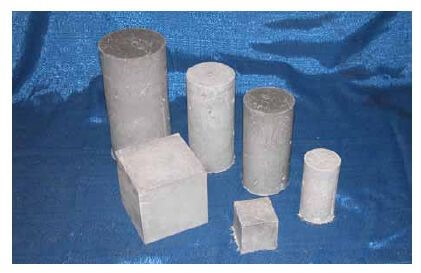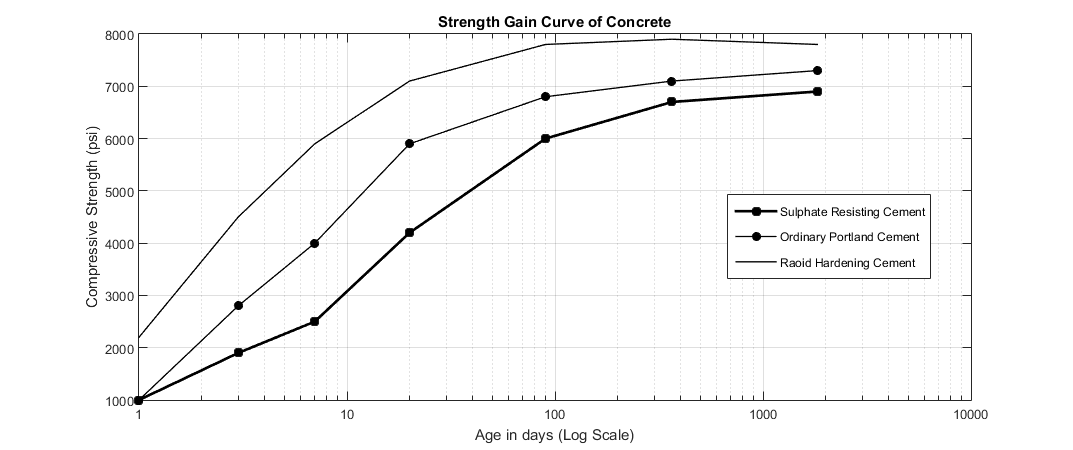 |
| Cube and Cylinder Specimens for Compression Strength Testing |
 Main Properties of Concrete for Construction
Main Properties of Concrete for Construction
Tahsina
Alam
Concrete is a mixture of several materials.
At the hardened state, this heterogeneous
material becomes stone-like mass.
The extensive use of concrete in the
construction field has made it a material of huge concern for engineers.
To participate in the vast uses of concrete
an engineer must know its properties. Here in this article, we have provided a
glimpse of the properties of concrete.
Strength
Strength of concrete are of the following
types:
a. Compressive strength
b. Tensile strength
c. Flexural strength
d. Shear strength
Compressive Strength
Two types of test specimens are used in
Bangladesh
(1) Cube and
(2) Cylinder
The cube specimens of concrete of the desired
proportion are cast in steel or cast iron molds, normally 6-inch cube.
The standard cylinder specimen of concrete is
6 inch in diameter and 12 inches in height and cast in a mold generally made of
cast iron;
Standard cubes and cylinders are tested at
prescribed ages, generally, 28 days, with additional tests often made at 1, 3,
and 7 days.
The specimens are tested for crushing
strength under a testing machine.
The cube tests give much greater values of
crushing strength, usually 20 to 30 % more than those given by cylinders.
According to British standard, the strength
of a cylinder specimen is equal to three-quarters of the strength of the cube
specimen.
Effect of age on concrete strength:
Concrete attains strength with time. Ordinary
cement concrete gains above 70 to 75% of its final strength within 28 days and
about 90 to 95 % in the course of one year.
It is often desirable to check the
suitability of a concrete long before the results of the 28-day test are
available.
When no specific data on the materials used
in making concrete are available, the 28-day strength may be assumed to be 1.5
times of the 7 days’ strength.
Tests have shown that for concrete made with
ordinary Portland cement the ratio of the 28 days to 7 days’ strength generally
lies between 1.3 to 1.7, and the majority of the results fall above 1.5.
The extrapolation of 28 days’ strength from
the 7 days’ strength is, therefore quite reliable;
The rate of gain of strength of the different
type of cement concretes are shown in the figure below


Tensile strength
Concrete is very weak in tension. The tensile
strength of ordinary concrete ranges from about 7 to 10 percent of the
compressive strength.
Flexural strength
The flexural strength of plain concrete is
almost wholly dependent upon the tensile strength.
However, experiments show that the modulus of
rupture is considerably greater than the strength in tension.
Shear strength
It is the real determining factor in the
compressive strength of short columns.
The average strength of concrete in direct
shear varies from about half of the compressive strength for rich mixtures to
about 0.8 of the compressive strength for lean mixtures.
Workability
The strength of concrete of a given mix
proportion is very seriously affected by the degree of its compaction.
It is therefore vital that the consistency of
the mix be such that the concrete can be transported, placed and finished
sufficiently easily and without segregation.
A concrete satisfying these conditions is
said to be workable.
Factors affecting the workability of concrete
are:
· Water Content
· Mix Proportions
· Size of Aggregates
· Shape of Aggregates
· Grading of Aggregates
· Surface Texture of
Aggregates
· Use of Admixtures
· Use of Supplementary
Cementitious Materials
· Time
· Temperature
Usually, Slump test is done to indirectly
determine the workability of a concrete mix.
Elastic Properties
Concrete is not perfectly elastic for any
range of loading, an appreciable permanent setting taking place for even low
loads.
The deformation is not proportional to the
stress at any stage of loading.
The elastic properties of concrete vary with
the richness of the mixture and with the intensity of the stress. They also
vary with the age of concrete.
Durability
Durability is the property of concrete to
withstand the condition for which it has been designed, without deterioration
over a period of years.
Lack of durability can be caused by external
agents arising from the environment or by internal agents within the concrete.
Causes can be categorized as physical,
mechanical and chemical.
Physical cause arises from the action of
frost and from differences between the thermal properties of aggregate and of
the cement paste, while mechanical causes are associated mainly with abortion.
Impermeability
Penetration of concrete by materials in
solution may adversely affect its durability, for instance, when Ca(OH)2 is
being leached out or an attack by aggressive liquids (acids) takes place.
Permeability has an important bearing on the
vulnerability of concrete to water and frost.
In the case of reinforced cement concrete,
the penetration of moisture and air will result in the corrosion of steel.
This leads to an increase in the volume of
the steel, resulting in cracking and spalling of the concrete. P
ermeability of concrete is also of importance
for liquid retaining and hydraulic structures;
Segregation
The tendency of separation of coarse
aggregate grains from the concrete mass is called segregation.
It increases when the concrete mixture is
lean and too wet.
It also increases when rather large and
rough-textured aggregate is used. The phenomenon of segregation can be avoided
as follows.
· Addition of little
air-entraining agents in the mix.
· Restricting the
amount of water to the smallest possible amount.
· All the operations
like handling, placing and consolidation must be carefully conducted.
· Concrete should not
be allowed to fall from large heights.
Bleeding
The tendency of water to rise to the surface
of freshly laid concrete is known as bleeding.
The water rising to the surface carries with
it, particles of sand and cement, which on hardening form a scum layer is
popularly known as laitance.
Concrete bleeding can be checked by adopting
the following measures.
· By adding more cement
· By using more finely
ground cement
· By properly designing
the mix and using the minimum quantity of water
· By using little air
entraining agent
· By increasing the
finer part of fine aggregate
Fatigue
Plain concrete when subjected to flexure,
exhibits fatigue.
The flexure resisting ability of concrete of
a given quality is indicated by an endurance limit whose value depends upon the
number of repetitions of stress.
In concrete pavement design, the allowable
flexural working stress is limited to 55% of the modulus of rupture.
Tahsina Alam, PE
Senior
Engineer at MnDOT
Greater
Minneapolis-St. Paul Area


No comments:
Post a Comment